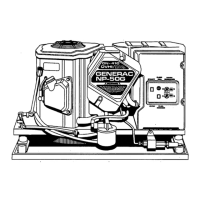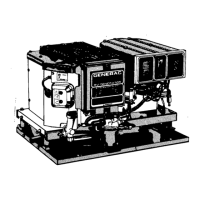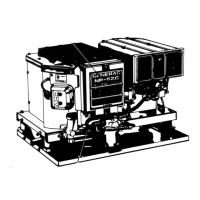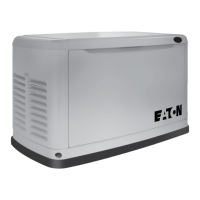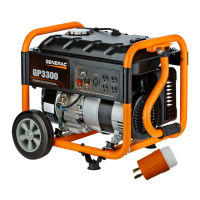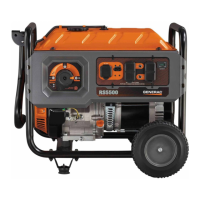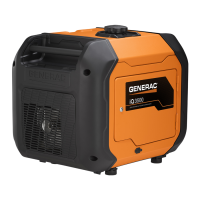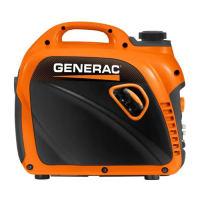Installing a gasoline fuel system (Figure 25) for recre-
ational
vehicle
generator
sets
must
comply
with
applicable
codes,
standards
and
regulations.
The
entire fuel system must be completely free of leaks.
There must be no possibility of gasoline vapors
enter-
ing the vehicle interior.
CARBURETOR
FUEL PUMP
DANGER:
GASOLINE
IS
HIGHLY
FLAMMABLE
AND
ITS
VAPORS
ARE
EXPLOSIVE.
COMPLY
WITH
All
CODES,
STANDARDS
AND
REGULA·
TIONS
PERTAINING
TO
GASOLINE
FUEL
SYS·
TEMS
USED
IN
RECREATIONAL
VEHICLE
GENER·
ATORS.
PROPERLY
INSTAll
AND
MAINTAIN
THE
FUEl
SYSTEM
AND
KEEP
IT
ENTIRELY
FREE
OF
LEAKS.
GASOLINE
VAPORS
MUST
NOT
ENTER
THE
VEHICLE
INTERIOR.
Factory installed generator fuel system components
include (a) fuel filter, (b)
1 2-volt DC electric pump, (c)
engine carburetor, and (d) interconnecting
lines and
fittings.
Connect
a fuel
supply
line to the fuel filter
inlet.
Use
a
flexible
length
of
approved
fuel
hose
between the fuel filter inlet connection and rigid fuel
lines.
FUEL
TANK
Either the generator must share the vehicle engine's
fuel tank,
or
you must install a separate fuel tank for
the generator set.
All fuel tanks installed on the vehi-
cle
must be constructed, installed, and restrained so it
complies with
applicable codes, standards and regu-
lations.
If
the generator is to share the vehicle engine's tank,
separate fuel pickup tubes are required for the engine
and
the
generator.
Generac
recommends
that
you
make the fuel pickup tube
2 to 3 inches shorter than
the vehicle engine's pickup tube. This prevents the
generator from depleting the entire
fuel supply during
prolonged generator operating periods.
GASOLINE FUEL SYSTEM
CAUTION:
Do
NOT
tee
the
generator
fuel
supply
line
into
the
vehicle
engine
fuel
supply
line.
If
this
is
done,
the
generator
will
be
starved
of
fuel
when
both
engines
are
operating
at
the
same
time.
Also,
while
the
vehicle
engine
is
not
running,
generator
operation
may
drain
the
vehicle
engine
supply
line,
making
it
difficult
to
start
the
vehicle
engine.
GENERATOR
FUEL
SUPPLY
LINE
•
RIGID
FUEL
LINES
Those
lines used to supply fuel from a
tank
to the
generator must
comply with applicable codes, stan-
dards and regulations.
The
following
general rules
apply
to rigid fuel lines:
•
Rigid
lines
should
be
of
annealed, seamless,
drawn
alu-
minum
or
steel.
•
Lines and
fittings
must
comply
with SAE J512F,
"Standard Automotive Fittings", or with
ANSI
8126.26
(latest edition).
•
Route
the
fuel
line
so
that
at
least 2 inches
of
clearance
is
maintained
between
the
line
and
any
exhaust
system
parts.
"
Do
not attach electrical wiring to fuel lines. Route
the
wiring
so
it
cannot
come
into
contact
with
any
fuel
line.
•
Route
fuel
lines
so
if
they leak, fuel does
not
drip
onto
any
electrical
or
exhaust
system
parts.
•
Use
non-ferrous metal straps without sharp edges
to
secure
fuel
lines.
•
FLEXIBLE
FUEL
LINE
Use an approved flexible length of fuel hose between
the generator fuel
inlet connection and rigid fuel lines.
This prevents breaking of the line caused by vibration,
shifting, settling
or
movement.
The
following
rules
apply:
•
The
flexible
hose
must
comply
with
SAE
J30B,
"Standard
for
Fuel
and
Oil
Hose".
It
must
be
approved
for
use
with
gasoline.
•
The
hose
should
be
at
least 6 inches longer than
is
need-
ed
to prevent
the
hose from rupturing
if
the generator
shifts
or
settles.
-21-
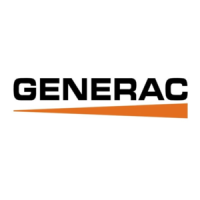
